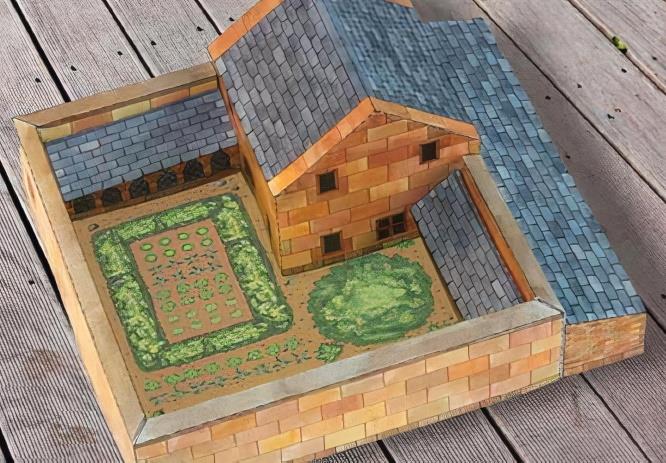"Discover the story of the 14th-century monastery Mount Grace Priory and the lives of the monks who lived there, before building your ownpaper model of a monk’s cell.
Life in a cell - Mount Grace Priory in North Yorkshire is a monastery that was founded in 1398 by Thomas de Holland, who was the nephew of King Richard II.
The lives of the medieval Carthusian monks who lived here were different to those of other monks. Each monk lived alone in their own house within the priory, which was known as a cell. The cells all had their own cloister for reading and meditation, as well as a walled garden.
Mount Grace Priory had space for 25 of these cells. The monks rarely saw each other spending most of the day in their cell, where they would say prayers and celebrate Mass. Servants, called ‘lay brothers’, brought food and drink to their cells, passing them through a hatch beside the door.
The monks’ days were only different on Sundays and feast days, when they would eat together, meet to discuss business and discipline, and go to church together to pray.
Most of the cells at Mount Grace had a similar layout. The ground floor had a living room, study and a bedroom with an oratory (private chapel), while there was a work room upstairs. The cloister was formed from a short corridor between the cell and the garden. A second corridor led to the latrine (toilet), which was in the garden wall away from the cell.
The cell gardens at Mount Grace Priory allowed monks to do manual labour without leaving the confines of their living space. The monks grew herbs for use as medicine and for their aromas, as well as beautiful flowering plants that were designed to lift the mind and spirit. They could also grow vegetables in their gardens.
Now you can make your very own model of a monk’s cell at Mount Grace Priory. Ask an adult to download the template and print it out for you, then you can follow the instructions below to build the cell.
Once you’ve completed it, put your model on display to impress your friends – and tell everyone about how medieval monks lived in monasteries!" - British Heritage
"Descubra a história do Mosteiro de Mount Grace do século XIV e a vida dos monges que viveram lá, antes de montar seu próprio modelo de papel da cela de um monge.
Vida em uma cela - O Mosteiro de Mount Grace, em North Yorkshire, é um mosteiro que foi fundado em 1398 por Thomas de Holland, sobrinho do Rei Ricardo II.
A vida dos monges cartuxos medievais que viveram aqui era diferente da dos outros monges. Cada monge vivia sozinho em sua própria casa dentro do mosteiro, que era chamada de cela. As celas tinham seu próprio claustro para leitura e meditação, além de um jardim murado.
Mount Grace Priory tinha espaço para 25 dessas celas. Os monges raramente se viam, passando a maior parte do dia em sua cela, onde rezavam e celebravam a Missa. Servos, chamados de "irmãos leigos", levavam comida e bebida para suas celas, passando-as por uma abertura ao lado da porta.
Os dias dos monges eram diferentes apenas aos domingos e em dias de festa, quando comiam juntos, se reuniam para discutir assuntos e disciplina, e iam à igreja juntos para rezar.
A maioria das celas em Mount Grace tinha um layout semelhante. O térreo tinha uma sala de estar, um estudo e um quarto com um oratório (capela privada), enquanto havia uma sala de trabalho no andar de cima. O claustro era formado por um corredor curto entre a cela e o jardim. Um segundo corredor levava ao latrino (banheiro), que ficava na parede do jardim, afastado da cela.
Os jardins das celas em Mount Grace Priory permitiam que os monges fizessem trabalhos manuais sem sair do espaço de convivência. Os monges cultivavam ervas para uso medicinal e para seus aromas, além de belas plantas floridas que eram projetadas para elevar a mente e o espírito. Eles também podiam cultivar vegetais em seus jardins.
Agora você pode criar seu próprio modelo de cela de um monge em Mount Grace Priory. Peça a um adulto para baixar o modelo e imprimi-lo para você, e então você pode seguir as instruções abaixo para construir a cela.
Depois de terminar, exiba seu modelo para impressionar seus amigos - e conte a todos sobre como os monges medievais viviam nos mosteiros!" - British Heritage






























